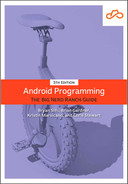In activity_main.xml, you specified attribute values in terms of dp units.
Now it is time to learn what they are.
Sometimes you need to specify values for view attributes in terms of specific sizes (usually in pixels, but sometimes points, millimeters, or inches). You see this most commonly with attributes for text size, margins, and padding. Text size is the pixel height of the text on the device’s screen. Margins specify the distances between views, and padding specifies the distance between a view’s outside edges and its content.
Android devices come in a wide variety of shapes and sizes. Even just among phones, specifications such as screen size and resolution vary widely. Modern phones have pixel densities ranging from less than 300 pixels per inch to more than 800 pixels per inch.
What happens when you want to display the same UI on different density screens? Or when the user configures a larger-than-default text size? It would be a very frustrating user experience if your button were tiny on one device and massive on another.
To provide a consistent experience on all devices, Android provides density-independent dimension units that you can use to get the same size on different screen densities. Android translates these units using the device’s defined density bucket to pixels at runtime, so there is no tricky math for you to do. These density buckets range from low density (LDPI) to medium density (MDPI) to high density (HDPI) and all the way up to extra-extra-extra-high density (XXXHDPI) (Figure 2.9).
In practice and in this book, you will use dp and sp almost exclusively. Android will translate these values into pixels at runtime.
